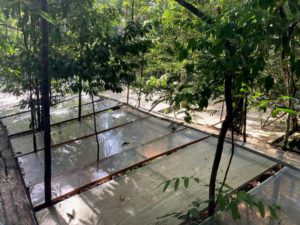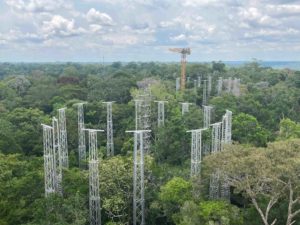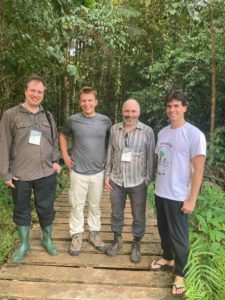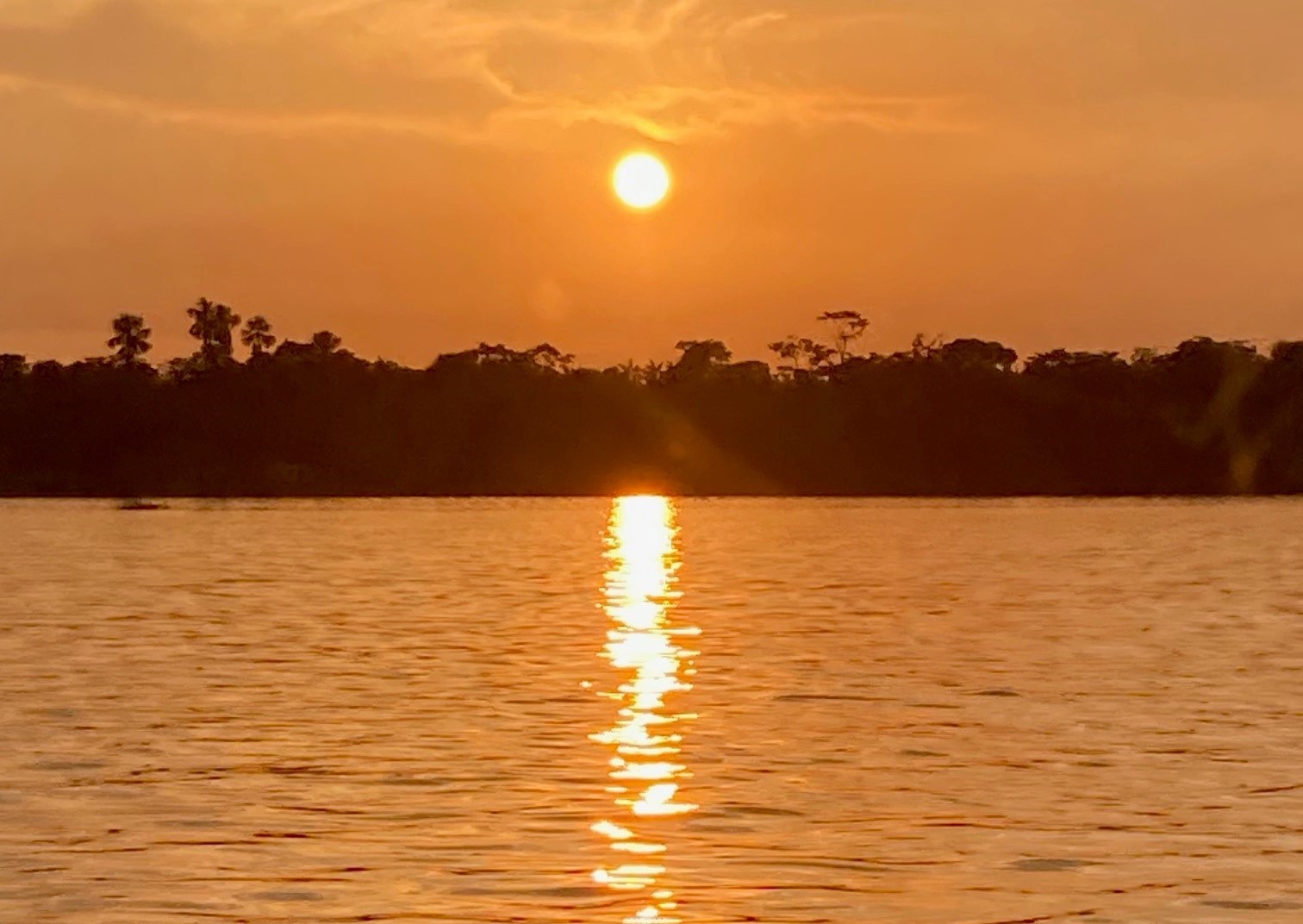By Prof Richard Betts, Chair in Climate Impacts, University of Exeter and Head of Climate Impacts, Met Office Hadley Centre
I’m approaching the end of an insightful 3-week visit to Brazil to visit two major field experiments in the Amazon and meet with various colleagues in different parts of the country. Having seen many places and met with many people, I’m struck by the incredible, world-leading science going on in Brazil, especially in the Amazon, and how deeply the University of Exeter and Met Office are involved in pushing the boundaries of our understanding of this crucial part of the Earth System.

In week 1, I visited the very impressive field experiment called ESECAFLOR (Efeitos da SECA na FLOResta – effects of drought on forest) in Caxiuanã National Forest in eastern Amazonia. A hectare of forest has been artificially droughted by covering the forest floor with a network of plastic panels and guttering that excludes 50% of the rain. It was set up 20 years ago by Antonio Lola da Costa from Universidade Federal do Pará and Patrick Meir from the University the University of Edinburgh. The impacts of the artificial drought on the forest are quite profound, with several trees having died due to drought stress, resulting in visibly open area in the forest which is particularly striking from the top of the measurement tower. Importantly, they’ve have discovered exactly how the trees die from drought, which is really important for improving our Earth System Models.
Our Exeter colleagues Lucy Rowland and Paulo Bittencourt have both worked at ESECAFLOR for many years, and are now working on a project there funded through the Met Office programme Climate Science for Services Partnership Brazil. Paulo had been there for some weeks before I visited, measuring water in plants.
Caxiuanã is a really beautiful place in a fairly remote region – a dramatic 24 hour journey through a stunning river network from the city of Belém, first on a public ferry travelling through the night to the town of Breves, then a smaller boat to take our group from Breves. The views of the forest from the tower are stunning, and in the evenings we took a refreshing swim in the river and listening to the calls of the howler monkeys in the distance.
The return journey was “entertaining” because our small boat broke down an hour into the journey in the middle of the Amazon river, so we had to wait until another boat passed by, hail it and ask for a tow to the bank. We limped to a place with phone reception and called for help from Prof Lola. He sent another boat to collect us, but having now been delayed for several hours we missed the ferry at Breves, so had to give chase in the small boat, catch up with the ferry and then board it (with all our luggage) while it was powering down the river – much to the amusement of the other ferry passengers.
In week 2 I headed to the São Jose dos Campos near São Paulo for meetings with various other collaborators and friends, including another Exeter colleague Luiz Aragao based at the National Institute for Space Research (INPE) and other Brazilian colleagues at INPE and CEMADEN (the national centre for disaster risk monitoring and early warning) who I’ve worked with through CSSP Brazil and also IPCC.


In week 3, I headed to a different part of the Amazon to visit our AmazonFACE experiment near Manaus, to once again meet up with Paulo who had transferred to there to do more plant water measurements. We were also joined by more colleagues, Exeter’s Iain Hartley and Met Office / Exeter joint post-holder Andy Wiltshire. “FACE” stands for Free Air CO2 Enrichment, and AmazonFACE is another hugely ambitious, globally-important experiment on a tropical forest led by our Brazilian friends Beto Quesada at the National Institute for Amazon Research and David Lapola of the University of Campinas. A large share of the funding coming from the UK government via the Met Office. We will be releasing carbon dioxide into the forest to see how it responds to the higher levels we expect to see in the future. It’s taken 18 months to build the infrastructure for the first phase of the experiment, and we hope to start it up properly early next year. So far there are two (of an eventual six) 30-metre wide rings of sixteen 35-metre high towers to release the CO2 into the forests, and two 50-metre high cranes with baskets to carry scientists up into the canopy to study it – we had rise in the basket, which once again gave breathtaking views over the forest and the experimental infrastructure. Paulo’s measurements are important to fill an important gap in the baseline data we need to have before the CO2 release starts.
Iain, Andy and I are attending a workshop of the international Scientific Steering Committee for the programme at INPA. Lucy and Lina Mercado are also part of this committee – they were unable to travel here on this occasion, but this shows how extensively the University of Exeter and Met Office are involved in this research.
The week in Manaus also brought back memories of my first visit here in 2002 with Peter Cox back in his Met Office days, when we attended a conference of the LBA (Large-scale Biosphere-atmosphere experiment in Amazonia) programme, to present early work on the now-famous “Amazon dieback” model projection. That visit was a key moment in getting us involved in the Amazon research community, and has certainly led to an enormous amount of collaboration, many papers and the big international research programmes that we now have major roles in. This is all central to improving understanding of the risks of a tipping point in the Amazon from a combination of anthropogenic climate change and deforestation. Spending a good amount of time deep in the forest experiencing its beauty and majesty has reminded me of what we are trying to save.

